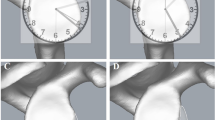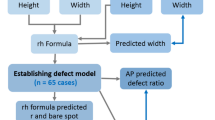Abstract
Purpose
Estimation of anterior glenoid bone loss is important for surgical decision-making. The purpose of this study was to describe a method for estimating anterior glenoid bone loss.
Methods
Thirty-nine cadaveric glenoids were digitized to obtain glenoid geometry. Glenoid bare spot centre, arthroscopic centre, and centre of the inferior glenoid circle relative to the geometric centre were measured. To simulate anterior glenoid bone loss, imaginary sequential osteotomies were created 0°, 22.5°, and 45° to the superior–inferior line in a 3D digitizing programme. Per cent of anterior glenoid bone loss area was calculated as the percentage of defect area relative to the entire area of the glenoid. The relationship between area loss and ratio of bone defect length to the distance from posterior glenoid to various centres was determined.
Results
As the ratio of bone defect length to the distance from posterior glenoid to all three centres increased, the per cent area of bone loss increased exponentially. The ratio using the inferior circle centre and arthroscopic centre was highly correlated to the actual glenoid bone loss in all osteotomies (R 2 > 0.90). The ratio using the centre of bare area had the lowest correlation. The ratio of defect length to distance from posterior glenoid to arthroscopic centre greater than 2.4 for 0° and 2.0 for 45° osteotomies results in bone loss area greater than 25 %. The bare area centre had the largest variation. Average bone loss was overestimated when the centre of bare spot was used compared to other centre locations.
Conclusion
Per cent of anterior glenoid bone loss can be estimated using the ratio of bone defect length to the distance from posterior glenoid rim to the centre of inferior glenoid circle or arthroscopic centre either preoperatively using 3D CT or arthroscopically which can be useful for determining surgical treatment.






Similar content being viewed by others
References
Bakshi NK, Patel I, Jacobson JA, Debski RE, Sekiya JK (2015) Comparison of 3-dimensional computed tomography-based measurement of glenoid bone loss with arthroscopic defect size estimation in patients with anterior shoulder Instability. Arthroscopy 31(10):1880–1885
Barchilon VS, Kotz E, Barchilon Ben-Av M, Glazer E, Nyska M (2008) A simple method for quantitative evaluation of the missing area of the anterior glenoid in anterior instability of the glenohumeral joint. Skelet Radiol 37(8):731–736
Barcia AM, Rowles DJ, Bottoni CR, Dekker TJ, Tokish JM (2013) Glenoid bare area: arthroscopic characterization and its implications on measurement of bone loss. Arthroscopy 29(10):1671–1675
Bishop JY, Jones GL, Rerko MA, Donaldson C (2013) 3-D CT is the most reliable imaging modality when quantifying glenoid bone loss. Clin Orthop Relat Res 471(4):1251–1256
Burkhart SS, De Beer JF (2000) Traumatic glenohumeral bone defects and their relationship to failure of arthroscopic Bankart repairs. Arthrosc J Arthrosc Relat Surg 16(7):677–694
Burkhart SS, Debeer JF, Tehrany AM, Parten PM (2002) Quantifying glenoid bone loss arthroscopically in shoulder instability. Arthroscopy 18(5):488–491
Chuang TY, Adams CR, Burkhart SS (2008) Use of preoperative three-dimensional computed tomography to quantify glenoid bone loss in shoulder instability. Arthroscopy 24(4):376–382
Detterline AJ, Provencher MT, Ghodadra N, Bach BR Jr, Romeo AA, Verma NN (2009) A new arthroscopic technique to determine anterior-inferior glenoid bone loss: validation of the secant chord theory in a cadaveric model. Arthroscopy 25(11):1249–1256
Gerber C, Nyffeler RW (2002) Classification of glenohumeral joint instability. Clin Orthop Relat Res 400:65–76
Griffith JF, Yung PS, Antonio GE, Tsang PH, Ahuja AT, Chan KM (2007) CT compared with arthroscopy in quantifying glenoid bone loss. Am J Roentgenol 189(6):1490–1493
Gyftopoulos S, Beltran LS, Yemin A, Strauss E, Meislin R, Jazrawi L, Recht MP (2014) Use of 3D MR reconstructions in the evaluation of glenoid bone loss: a clinical study. Skelet Radiol 43(2):213–218
Huijsmans PE, de Witte PB, de Villiers RV, Wolterbeek DW, Warmerdam P, Kruger NR, de Beer JF (2011) Recurrent anterior shoulder instability: accuracy of estimations of glenoid bone loss with computed tomography is insufficient for therapeutic decision-making. Skelet Radiol 40(10):1329–1334
Huysmans PE, Haen PS, Kidd M, Dhert WJ, Willems JW (2006) The shape of the inferior part of the glenoid: a cadaveric study. J Shoulder Elb Surg 15(6):759–763
Itoi E, Lee SB, Amrami KK, Wenger DE, An KN (2003) Quantitative assessment of classic anteroinferior bony Bankart lesions by radiography and computed tomography. Am J Sports Med 31(1):112–118
Kralinger F, Aigner F, Longato S, Rieger M, Wambacher M (2006) Is the bare spot a consistent landmark for shoulder arthroscopy? A study of 20 embalmed glenoids with 3-dimensional computed tomographic reconstruction. Arthroscopy 22(4):428–432
Kubicka AM, Stefaniak J, Lubiatowski P, Dlugosz J, Dzianach M, Redman M, Piontek J, Romanowski L (2016) Reliability of measurements performed on two dimensional and three dimensional computed tomography in glenoid assessment for instability. Int Orthop. doi:10.1007/s00264-016-3253-9
Lo IK, Parten PM, Burkhart SS (2004) The inverted pear glenoid: an indicator of significant glenoid bone loss. Arthroscopy 20(2):169–174
Maqdes A, Chammai Y, Lengert R, Klouche S, Clavert P, Hardy P, Kempf JF (2014) The intra- and inter-observer reliability of the CT-scan based X index to quantify glenoid bone loss in chronic anterior shoulder instability and its impact on decision making. Eur J Orthop Surg Traumatol 25:699–703
Miyatake K, Takeda Y, Fujii K, Takasago T, Iwame T (2014) Validity of arthroscopic measurement of glenoid bone loss using the bare spot. Open Access J Sports Med 5:37–42
Moroder P, Resch H, Schnaitmann S, Hoffelner T, Tauber M (2013) The importance of CT for the pre-operative surgical planning in recurrent anterior shoulder instability. Arch Orthop Trauma Surg 133(2):219–226
Pavlov H, Warren RF, Weiss CB Jr, Dines DM (1985) The roentgenographic evaluation of anterior shoulder instability. Clin Orthop Relat Res 194:153–158
Piasecki DP, Verma NN, Romeo AA, Levine WN, Bach BR Jr, Provencher MT (2009) Glenoid bone deficiency in recurrent anterior shoulder instability: diagnosis and management. J Am Acad Orthop Surg 17(8):482–493
Provencher MT, Bhatia S, Ghodadra NS, Grumet RC, Bach BR Jr, Dewing CB, LeClere L, Romeo AA (2010) Recurrent shoulder instability: current concepts for evaluation and management of glenoid bone loss. J Bone Joint Surg Am 92(Suppl):2133–2151
Provencher MT, Detterline AJ, Ghodadra N, Romeo AA, Bach BR Jr, Cole BJ, Verma N (2008) Measurement of glenoid bone loss: a comparison of measurement error between 45 degrees and 0 degrees bone loss models and with different posterior arthroscopy portal locations. Am J Sports Med 36(6):1132–1138
Rokous JR, Feagin JA, Abbott HG (1972) Modified axillary roentgenogram. A useful adjunct in the diagnosis of recurrent instability of the shoulder. Clin Orthop Relat Res 82:84–86
Saintmard B, Lecouvet F, Rubini A, Dubuc JE (2009) Is the bare spot a valid landmark for glenoid evaluation in arthroscopic Bankart surgery? Acta Orthop Belg 75(6):736–742
Saito H, Itoi E, Sugaya H, Minagawa H, Yamamoto N, Tuoheti Y (2005) Location of the glenoid defect in shoulders with recurrent anterior dislocation. Am J Sports Med 33(6):889–893
Sommaire C, Penz C, Clavert P, Klouche S, Hardy P, Kempf JF (2012) Recurrence after arthroscopic Bankart repair: Is quantitative radiological analysis of bone loss of any predictive value? Orthop Traumatol Surg Res 98(5):514–519
Stecco A, Guenzi E, Cascone T, Fabbiano F, Fornara P, Oronzo P, Grassi FA, Cecchi G, Caniggia M, Brambilla M, Carriero A (2013) MRI can assess glenoid bone loss after shoulder luxation: inter- and intra-individual comparison with CT. Radiol Med 118(8):1335–1343
Sugaya H, Kon Y, Tsuchiya A (2005) Arthroscopic repair of glenoid fractures using suture anchors. Arthroscopy 21(5):635e1-e5
Sugaya H, Moriishi J, Dohi M, Kon Y, Tsuchiya A (2003) Glenoid rim morphology in recurrent anterior glenohumeral instability. J Bone Joint Surg Am 85a(5):878–884
Sugaya H, Moriishi J, Kanisawa I, Tsuchiya A (2005) Arthroscopic osseous Bankart repair for chronic recurrent traumatic anterior glenohumeral instability. J Bone Joint Surg Am 87(8):1752–1760
Author information
Authors and Affiliations
Corresponding author
Ethics declarations
Conflict of interest
The authors declare that they have no conflict of interest.
Funding
Grant sponsor: National Research Foundation of Korea (NRF); Grant number: NRF-2013RIAIA2008601. Partial funding provided by VA Rehabilitation Research and Development Merit Review, California Orthopaedic Research Institute and the John C. Griswold Foundation. The funding source did not play a role in the investigation.
Ethical approval
This article does not contain any studies with human participants or animals performed by any of the authors.
Informed consent
None.
Rights and permissions
About this article
Cite this article
Shin, SJ., Jun, B.J., Koh, Y.W. et al. Estimation of anterior glenoid bone loss area using the ratio of bone defect length to the distance from posterior glenoid rim to the centre of the glenoid. Knee Surg Sports Traumatol Arthrosc 26, 48–55 (2018). https://doi.org/10.1007/s00167-016-4312-x
Received:
Accepted:
Published:
Issue Date:
DOI: https://doi.org/10.1007/s00167-016-4312-x




